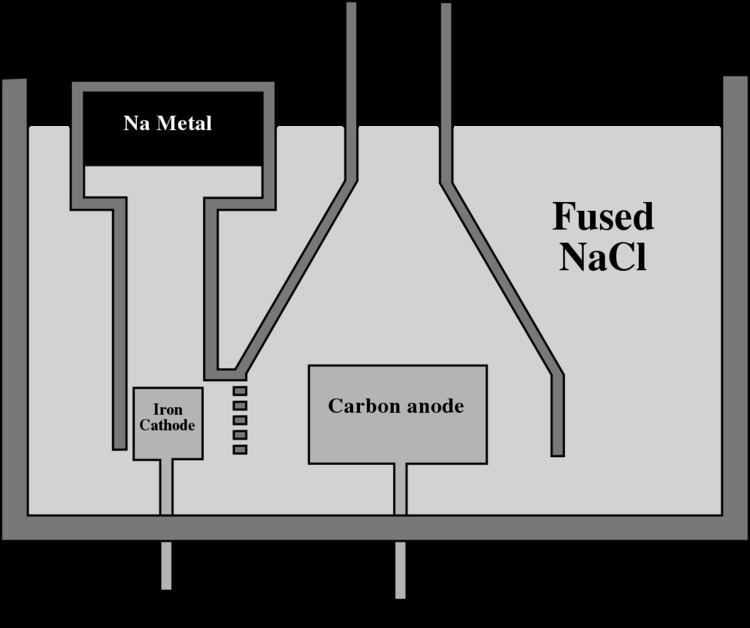 | ||
The Downs' process is an electrochemical method for the commercial preparation of metallic sodium, in which molten NaCl is electrolyzed in a special apparatus called the Downs cell.
How it works
The Downs cell uses a carbon anode and an iron cathode. The electrolyte is sodium chloride that has been heated to the liquid state. Although solid sodium chloride is a poor conductor of electricity, when molten the sodium and chloride ions are mobilized, which become charge carriers and allow conduction of electric current.
Some calcium chloride and/or chlorides of barium and strontium, and, in some processes, sodium fluoride are added to the electrolyte to reduce the temperature required to keep the electrolyte liquid. Sodium chloride melts at 1074 Kelvin, but a salt mixture can be kept liquid at a temperature as low as 505 °C at the mixture containing, by weight: 33.2% NaCl and 66.8% CaCl2. If pure sodium chloride is used, a metallic fog is formed in the molten NaCl which is impossible to separate. Therefore, one option is to have a NaCl (42%) and CaCl2 (58%) mixture.
The anode reaction is:
The cathode reaction is:
for an overall reaction of
The calcium does not enter into the reaction because its reduction potential of 2.87 volts is higher than that of sodium. Hence the sodium ions are reduced to metallic form in preference to those of calcium. If the electrolyte contained only calcium ion and no sodium, it would be calcium metal produced as the cathode product (which indeed is how metallic calcium is produced).
Both the products of the electrolysis, sodium metal and chlorine gas, are less dense than the electrolyte and therefore float to the surface. Perforated iron baffles are arranged in the cell (see the adjacent diagram) to direct the products into separate chambers without their ever coming into contact with each other.
Although theory predicts that a potential of a little over 4 volts should be sufficient to cause the reaction to go forward, in practice potentials of up to 8 volts are used. This is done in order to achieve useful current densities in the electrolyte despite its inherent electrical resistance. The overvoltage and consequent resistive heating contributes to the heat required to keep the electrolyte in a liquid state.
The Downs' process also produces chlorine as a byproduct, although chlorine produced this way accounts for only a small fraction of chlorine produced industrially by other methods.
